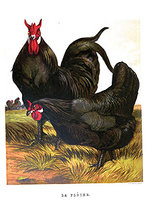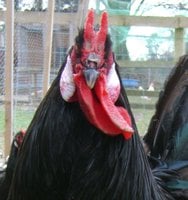Clucksworth12
Chirping
Alot of chickens have names based on their combs, right? And for other unique traits of their breed, or even where and how they The silkies for instance- wait- do I need to elaborate on that? I think their name says enough. Then their is the rosecomb, the Jersey GIANT, sebright, Rhode Island reds, Rhode Island whites, Sumatras, Javas, California Grays, khaki Campbell, and call ducks.
But I want to tell you about a breed that you may or may not know alot about. The Devil bird. Wait, let me clear up that it's actual name is La Fleche, but most people call them devil birds.
Why?
Their combs!
They have one of the most unique combs in all of chickendom, a prefect V shape. Even if you didn't know, when you saw this bird, you'd instantly think "Devil".
So now I'll tell a little more about this absolutely amazing piece of poultry.
They are an old meat breed from France, named after the village of La Flèche (not far from the racing city of Le Mans). They can be found in both large and bantam sizes, but are almost always found in black. They are very flighty and independent birds, doing well free ranging. But yet they can adapt to confinement. They are very capable fliers, so you'll need a high fence if you wish to keep them.
The La Fleche has white earlobes, long wattles, a broad breast, full feathering, and tight feathers. They lay s respectable amount of white eggs, even through winter months. The hens very rarely go broody.
The breed is actually known in France for the meat production, due to its large breasts.
The breed is thought to be developed by crossing Crevecoeur and either a White-faced Spanish or Minorca.
The breed was first written about in 1580 by Prudens Choiselat, a very popular economist of the period who wrote, "A discourse on husbandry, no less profitable than delectable."
The breed is slow to mature, somewhat standoffish, but yet are very active.
The La Fleche was first admitted to the APA in 1874.
Class- Standard, continental.
Bantam, all other combs, clean legged.
Size- Standard cock: 8 Ib. (3.56 kg) / Standard hen: 6.5 Ib. (3 kg) / Bantam cock: 30 oz. (850 g) / bantam hen: 26 oz. (740 g) /
Comb, wattles, and earlobes- Large V-shaped comb likened to horns, well rounded wattles may be pendolous; earlobes are large. Combs and wattles are bright red; earlobes are white.
Color- Beak is black shading to horn at tip, eyes are reddish bay; shanks and toes are dark laden blue. Plumage is standard black.
Place of origin- France
Conservation status- critical. This breed needs devoted breeders willing to help conserve it.
Special qualities- good dual purpose breed.
But I want to tell you about a breed that you may or may not know alot about. The Devil bird. Wait, let me clear up that it's actual name is La Fleche, but most people call them devil birds.
Why?
Their combs!
They have one of the most unique combs in all of chickendom, a prefect V shape. Even if you didn't know, when you saw this bird, you'd instantly think "Devil".
So now I'll tell a little more about this absolutely amazing piece of poultry.
They are an old meat breed from France, named after the village of La Flèche (not far from the racing city of Le Mans). They can be found in both large and bantam sizes, but are almost always found in black. They are very flighty and independent birds, doing well free ranging. But yet they can adapt to confinement. They are very capable fliers, so you'll need a high fence if you wish to keep them.
The La Fleche has white earlobes, long wattles, a broad breast, full feathering, and tight feathers. They lay s respectable amount of white eggs, even through winter months. The hens very rarely go broody.
The breed is actually known in France for the meat production, due to its large breasts.
The breed is thought to be developed by crossing Crevecoeur and either a White-faced Spanish or Minorca.
The breed was first written about in 1580 by Prudens Choiselat, a very popular economist of the period who wrote, "A discourse on husbandry, no less profitable than delectable."
The breed is slow to mature, somewhat standoffish, but yet are very active.
The La Fleche was first admitted to the APA in 1874.
Class- Standard, continental.
Bantam, all other combs, clean legged.
Size- Standard cock: 8 Ib. (3.56 kg) / Standard hen: 6.5 Ib. (3 kg) / Bantam cock: 30 oz. (850 g) / bantam hen: 26 oz. (740 g) /
Comb, wattles, and earlobes- Large V-shaped comb likened to horns, well rounded wattles may be pendolous; earlobes are large. Combs and wattles are bright red; earlobes are white.
Color- Beak is black shading to horn at tip, eyes are reddish bay; shanks and toes are dark laden blue. Plumage is standard black.
Place of origin- France
Conservation status- critical. This breed needs devoted breeders willing to help conserve it.
Special qualities- good dual purpose breed.




